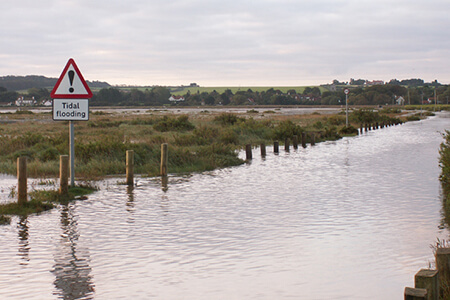This is a lesson summary. The full lesson can be viewed by purchasing an online course subscription.
Learning Objective
In this lesson we will learn how gravitational forces exerted by the Moon and Sun create tides on Earth.
Learning Outcomes
By the end of this lesson you will be able to:
- Explain how gravitational force affects objects.
- Describe how Earth’s gravitational force affects the Moon and how the Moon’s gravitational force affects Earth.
- Describe Earth’s tidal bulges and explain why they occur on opposite sides of Earth.
- Explain how tides are a result of both the gravitational pull of the Moon and Earth’s rotation.
- Describe high tides and low tides and explain how they relate to a location’s orientation relative to the Moon.
- Explain how the gravitational pull of the Sun contributes to spring tides and neap tides.
- Describe how coastal topography and Earth’s distance from the Moon and Sun affect the magnitude of tides.

(Image: simonXT2, Adobe Stock)
Lesson Summary
- Gravity is a very weak force of attraction that exists between all objects.
- The magnitude of gravitational force between two objects depends on the mass of each object and the distance between them.
- Earth’s gravitational pull on the Moon keeps the Moon in orbit around Earth.
- It also distorts the Moon’s shape, causing it to bulge slightly on the near and far sides.
- The Moon’s gravitational pull on Earth distorts Earth’s shape, causing it to bulge slightly on the near and far sides.
- Earth bulges more than the Moon as its surface is mostly covered in water.
- The Moon and Earth don’t bulge because of the size of the gravitational forces acting on them, but because of the differences in gravitational force on their near side compared to their far side.
- The swelling of Earth’s surface water as the result of the Moon’s gravitational pull is known as a tidal bulge.
- Tides are the alternating rising and falling of sea levels that occurs as Earth’s tidal bulges move around the Earth as the Earth rotates on its axis.
- A high tide is the maximum sea level resulting from a region being at the centre of a tidal bulge.
- Two high tides occur simultaneously on Earth at all times – one on the side facing towards the Moon and one on the side facing away from the Moon.
- For any given region, there are usually two high tides each day – one when it is facing towards the Moon and one when it is facing away from the Moon.
- A low tide is the minimum sea level resulting from a region being midway between the two tidal bulges.
- Two low tides occur simultaneously on Earth at all times, on opposite sides of Earth, midway between the regions experiencing high tides.
- For any given region, there are usually two low tides each day, midway between each high tide.
- The time between two high tides or two low tides is approximately 12 hours and 25 minutes.
- It is slightly more than 12 hours because Earth has to rotate a little bit more than once for the same region to be facing the Moon, as the Moon has move during that time.
- The Sun’s gravitational pull affects the magnitude of tides.
- A spring tide occurs when the Earth, Moon and Sun are aligned – in other words, during a Full Moon and a New Moon.
- At these times, the combined gravitational forces of the Moon and Sun are at a maximum, resulting in the largest tidal bulges and therefore the largest difference between high and low tide.
- A neap tide occurs when the Moon and Sun are perpendicular to Earth – in other words, during a First Quarter Moon and a Third Quarter Moon.
- At these times, the combined gravitational forces of the Moon and Sun are at a minimum, resulting in the smallest tidal bulges and therefore the smallest difference between high and low tide.
- The magnitude of tides is also affected by the Moon’s distance from Earth, Earth’s distance from the Sun, coastal topography and weather.

(Image: Geoff Clark, Wikimedia Commons)
(Header image: Juan Carlos Munoz, Adobe Stock)
